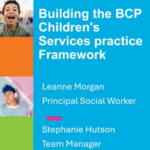CASE NOTES
Practitioners: Jo Phelps, home manager; and Debbie Williams, assistant care service manager.
Field: Residential care for older people.
Location: Worcestershire.
Client: Rita Wallace is a 90-year-old woman who lives alone in her own flat. Her son, Dougie Wallace, and his family live nearby.
Case History: After a urinary infection Rita was taken into hospital, having been found walking the streets confused. Dougie was worried that she could no longer stay safely at home. He was impressed with the ethos and environment of a nearby care home – a 60-bed voluntary sector home which had been rebuilt and opened in January 2001. Each resident’s room had its own front door with lock, bell and letter box. Although the home was registered to accept residents with dementia it was not a specialised home and Rita could not be supervised 24 hours a day.
Dilemma: Rita’s walking was the reason the family felt Rita could no longer live safely alone. And yet the home into which she planned to move did not have a secure unit and could not guarantee to prevent her walking out.
Risk factor: Rita, who is frail and confused, could walk into the busy main street outside the home.
Outcome: The home managed Rita’s walking tendencies and she continues to live happily at the home.
A worry held by many older people about going into hospital or care is that they might cease to be “a person” and become just another patient or resident pigeon-holed by illness, ailments or needs.
This feared loss of identity or acknowledgement of the intrinsic self can often be the trigger to physical and mental deterioration.
However, care homes, often seen as a last resort, can be a positive choice and have a crucial role to play. Well-run, person-centred homes can foster independence, choice and fulfilment.
For 90-year-old Rita Wallace, and her family, a care home was not seen as “the end” but simply a new chapter in an extraordinary woman’s life. Although lucid, she did become confused, would experience memory losses and would walk off.
At the care home selected for Rita, residents, within their capabilities, are free to come and go. One couple still drives. This suited the family who described Rita as “a free spirit”. But it also presented a dilemma.
“The risk we faced was Rita walking off because we are not a secure home,” says assistant care service manager, Debbie Williams. “I spoke to the social worker who felt that the risk was minimal to Rita’s quality of life. The son, Dougie, said her mum was a free spirit and didn’t want her in a secure unit.” An initial four-week placement was agreed.
“When Rita came here I don’t think she was really aware of what was happening or where she was,” says Phelps. “She arrived at reception and thought it was a hotel. And the first thing she asked for was a beer. We showed her to room and settled her in. And she did have a beer with her lunch.”
Dougie signed a risk assessment acknowledging the risks and the home’s risk management plan. “This involved staff carrying out hourly checks on Rita’s whereabouts,” says Williams. “We recorded the clothes that she put on each morning so that if she did walk off, the police would have a description of what she was wearing. She also carried an identity card in her handbag and coat pocket.”
Inevitably, Rita did walk off. “She went to the shops a couple of times but forgot where she was going but did manage to get back,” says Williams. “After four weeks we felt that she hadn’t been here long enough to make a final decision.” So an extension was agreed.
However, soon after Rita did go missing. Williams says: “She was missed on the hourly check and was gone for at least a couple of hours. We searched everywhere for her; the police were involved because we were treating it as a missing person.” Rita had walked to Great Malvern – about a mile away and all uphill – to her former flat.
Williams continues: “We had a call from one of Rita’s old neighbours saying she was with them. I picked her up. Rita was upset but I just explained to her that she lived at the home now. She was quite happy when we got back.”
After a review meeting a care home inspector, who had been kept fully informed, felt Rita was unsuitably placed. “We felt she wasn’t,” says Phelps. “Her family felt she wasn’t. And Rita herself was quite settled, content and happy. We wanted to manage the risk realistically and not just respond with a knee-jerk reaction and pack her off to an elderly mentally infirm unit when something didn’t quite go to plan. She would feel like she was trapped and her well-being would deteriorate.”
The home made some changes. The hourly checks became half-hourly. “A couple of times she would say she wanted to go to the shops so we arranged someone to go with her,” says Williams. “Dougie agreed to pay someone to take her out each week. But when we set that up Rita said she didn’t want to go out.”
It turned out that Rita’s main motivation to leave the home was to buy a newspaper. “All her life she’d only ever had a paper three times a week,” says Williams. “Because she was forgetful, she’d think it was a day she had a paper, which it wasn’t, and then make off for the shops. So we just ordered in a paper everyday – and minimised the risk that way.”
Rita remains a resident at the home. “She’s very settled and we have no problems at all,” says Phelps. “She doesn’t really mention her old flat any longer – she sees this as her home now. Although she was confused and had memory problems we felt it wasn’t fair to send her to a secure unit and take away her right to go out. Basically, we wanted to maintain her rights.”
Arguments For Risk
- Rita wanted to move in to the home. “She had resigned herself to moving in because she said Dougie was worried about her living alone,” says Williams. Sensibly the home offered an initial four-week placement to see how things went.
- The family were supportive. “They only wanted what’s best for mum,” says Phelps. “They said she was a free spirit and they want her to continue to be a free spirit.”
- Moving into a new home is an anxious time for everyone. Rita needed time to adjust to her new surroundings. If she settled there was every chance she might not walk off so much.
- The home and family stuck to their guns despite external pressure. “The big issue for Rita was the people who wanted her shipped out – and we weren’t prepared to give in that easily. We felt that we could, with the family’s written agreement, put realistic protective measures in place.”
Arguments Against Risk
- When care workers and family members decide to ignore professional advice, in this case from the social care regulator who felt Rita Wallace’s placement was unsuitable, the outcome can make them look very brave. It could also smack of incompetence.
- Rita was felt to be at risk living alone. It must surely follow that if she is therefore to be kept safe she needs continual vigilance – something a large, three-floor home with 60 older residents with differing levels of need, and often the minimum requirement of eight care staff on duty, can never provide.
- The family appears a strong motivator in this case. As Phelps says: “The family wanted to sign a disclaimer that they won’t hold the home in any way responsible should Rita walk off and get run over.” However, it cannot be said that the motivation of families is always with the older person’s interests at heart.
Independent Comment
Even his ever-caring sister couldn’t keep Wordsworth from wandering – lonely as a cloud and so on – but care practitioners now worry about the risks, writes Jef Smith. I doubt that people with dementia do “wander” in the full romantic, aimless sense. Rita Wallace had purposes in mind for her excursions – shopping, visiting her flat, collecting newspapers; modest ventures for a free spirit. She was in little real danger, even in busy streets, so her inability to find her way back was no more than an inconvenience. She might, quite lucidly, have agreed to wear an electronic tag as an aid to those who had to search for her.
The risk assessment reached a relaxed conclusion. A home that can serve a new resident beer on demand instantly earns my respect, but the way in which the care developed – using dress as an identifier, stepping up the checks, negotiating with Dougie for an extra escort when needed – was splendidly personalised. With home, family and resident of one mind, who was worried?
The inspector who initially objected was not simply being bureaucratic. Some unscrupulous homes do seek to admit or retain people for whom they lack suitable facilities, providing sub-standard care in the process. On the other hand, one responsible manager tells me he has instructed care staff never to write the “d” word on case notes for fear of prejudicing the home’s registration and forcing several residents into unwelcome moves. Using sensible discretion to allow a placement to continue worked in this case, but there’s an issue here to which the Commission for Social Care Inspection needs to give serious thought.
Jef Smith is a writer, trainer and consultant in the care of older people.



 Bournemouth, Christchurch and Poole
Bournemouth, Christchurch and Poole  Hampshire County Council
Hampshire County Council  Oxfordshire County Council
Oxfordshire County Council  South Gloucestershire Council
South Gloucestershire Council  Wokingham Borough Council
Wokingham Borough Council  Webinar: building a practice framework with the influence of practitioner voice
Webinar: building a practice framework with the influence of practitioner voice  ‘They don’t have to retell their story’: building long-lasting relationships with children and young people
‘They don’t have to retell their story’: building long-lasting relationships with children and young people  Podcast: returning to social work after becoming a first-time parent
Podcast: returning to social work after becoming a first-time parent  How managers are inspiring social workers to progress in their careers
How managers are inspiring social workers to progress in their careers  Workforce Insights – showcasing a selection of the sector’s top recruiters
Workforce Insights – showcasing a selection of the sector’s top recruiters 

 Facebook
Facebook X
X LinkedIn
LinkedIn Instagram
Instagram
Comments are closed.